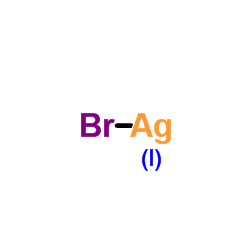Silver bromide

Silver bromide structure
|
Common Name | Silver bromide | ||
|---|---|---|---|---|
| CAS Number | 7785-23-1 | Molecular Weight | 187.772 | |
| Density | 6.473 g/mL at 25ºC(lit.) | Boiling Point | 700ºC | |
| Molecular Formula | AgBr | Melting Point | 432ºC(lit.) | |
| MSDS | Chinese USA | Flash Point | N/A | |
|
Visible light photocatalytic activity enhancement and mechanism of AgBr/Ag3PO4 hybrids for degradation of methyl orange.
J. Hazard. Mater. 217-218 , 107-15, (2012) Novel AgBr/Ag(3)PO(4) hybrids were synthesized via an in situ anion-exchange method and characterized by X-ray diffraction (XRD), field emission scanning electron microscopy (FE-SEM), energy-dispersive spectroscopy (EDS) and UV-vis diffuse reflectance spectro... |
|
|
Cetyltrimethylammonium bromide silver bromide complex as the capping agent of gold nanorods.
Langmuir 24(17) , 9219-22, (2008) A complex between cetyltrimethylammonium bromide (CTAB) surfactant and silver bromide (CTASB) is recognized by NMR and X-ray photoelectron spectroscopy (XPS) to be the entity at the surface of gold nanorods, resulting from an in situ formation in the classica... |
|
|
Role of hydroxyl radicals and mechanism of Escherichia coli inactivation on Ag/AgBr/TiO2 nanotube array electrode under visible light irradiation.
Environ. Sci. Technol. 46(7) , 4042-50, (2012) A ternary Ag/AgBr/TiO(2) nanotube array electrode with enhanced visible-light activity was synthesized by a two-step approach including electrochemical process of anodization and an in situ photoassisted deposition strategy. The dramatically enhanced photoele... |
|
|
Disruption and activation of blood platelets in contact with an antimicrobial composite coating consisting of a pyridinium polymer and AgBr nanoparticles.
ACS Appl. Mater. Interfaces 1(9) , 2049-54, (2009) Composite materials made up from a pyridinium polymer matrix and silver bromide nanoparticles embedded therein feature excellent antimicrobial properties. Most probably, the antimicrobial activity is related to the membrane-disrupting effect of both the polym... |
|
|
Photocatalytic activity of novel AgBr/WO3 composite photocatalyst under visible light irradiation for methyl orange degradation.
J. Hazard. Mater. 190(1-3) , 700-6, (2011) A novel AgBr/WO(3) composite photocatalyst was synthesized by loading AgBr on WO(3) substrate via deposition-precipitation method and characterized by XRD, SEM and DRS. The as-prepared AgBr/WO(3) was composed of monoclinic WO(3) substrate and face-centered cu... |
|
|
Photoreactivity preservation of AgBr nanowires in confined nanospaces.
Adv. Mater. 22(29) , 3156-60, (2010)
|
|
|
Facile fabrication of efficient AgBr-TiO2 nanoheterostructured photocatalyst for degrading pollutants and its photogenerated charge transfer mechanism.
J. Hazard. Mater. 243 , 169-78, (2012) A simple microemulsion-like chemical precipitation method has been successfully developed to construct effectively-contacted AgBr-TiO(2) composite. The key of this method is the dual roles of Br(-) in the synthetic process, as linkers between cetyltrimethyl a... |
|
|
Facile subsequently light-induced route to highly efficient and stable sunlight-driven Ag-AgBr plasmonic photocatalyst.
Langmuir 26(24) , 18723-7, (2010) In this paper, we successfully fabricate a stable and highly efficient direct sunlight plasmonic photocatalyst Ag-AgBr through a facile hydrothermal and subsequently sunlight-induced route. The diffuse reflectance spectra of Ag-AgBr indicate strong absorption... |
|
|
In situ ion exchange synthesis of the novel Ag/AgBr/BiOBr hybrid with highly efficient decontamination of pollutants.
Chem. Commun. (Camb.) 47(25) , 7054-6, (2011) A novel Ag/AgBr/BiOBr hybrid was prepared by a rational in situ ion exchange reaction between BiOBr hierarchical microspheres and AgNO(3) in ethylene glycol followed by light reduction, which displayed superior visible light driven photocatalytic activities i... |
|
|
Facile synthesis of AgBr nanoplates with exposed {111} facets and enhanced photocatalytic properties.
Chem. Commun. (Camb.) 48(2) , 275-7, (2012) AgBr nanoplates with exposed {111} facets have been synthesized in high yield by a facile precipitation reaction, and the as-prepared nanoplates exhibited greatly enhanced photocatalytic properties for the degradation of organic pollutants, which may be prima... |